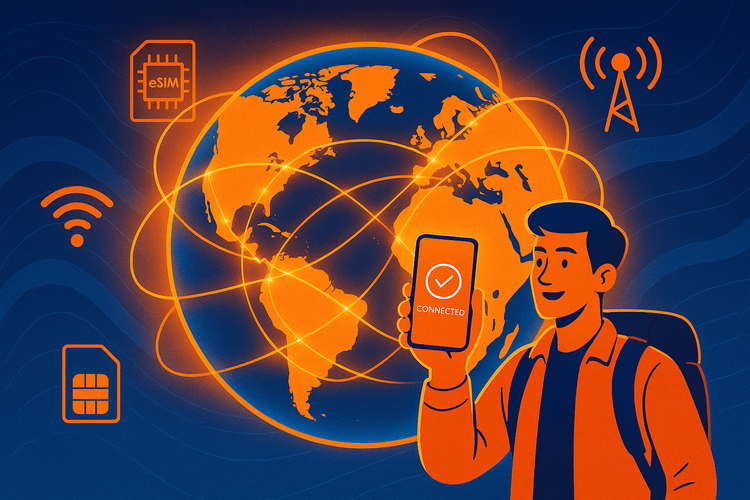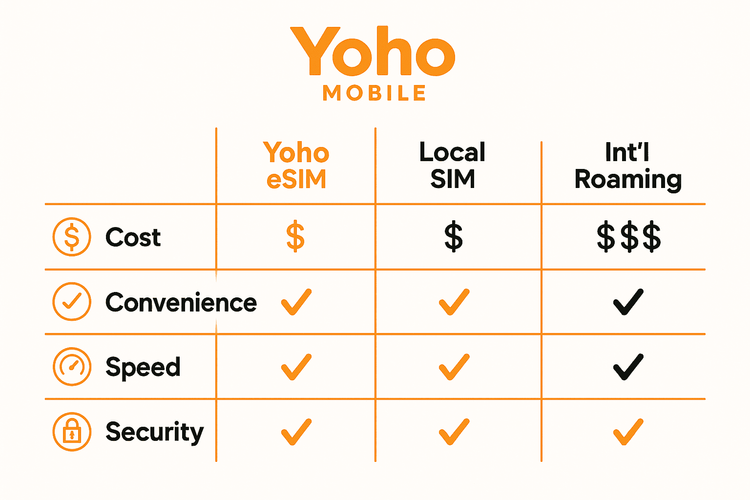The 2026 Ultimate Guide to International Internet: eSIM vs Local SIM
Marcos•Aug 26, 2025
Staying connected while traveling abroad is no longer a luxury—it’s an essential. From navigating with Google Maps in Tokyo to sharing your adventures from the beaches of Thailand, reliable travel data is the key to a smooth journey. But as we head into 2026, the landscape of international internet options has evolved. Gone are the days of accepting exorbitant roaming fees as the only choice.
Today, you’re faced with four main contenders: the modern eSIM, the traditional local SIM card, your home carrier’s international roaming plan, and the portable pocket WiFi. Which one is the best? The answer depends on your travel style, budget, and needs.
This comprehensive guide will break down each option based on cost, convenience, speed, and security, helping you make the smartest choice for your next trip. Ready to travel smarter? Let’s dive in. And if you’re already curious about the future of travel connectivity, why not get a free trial eSIM from Yoho Mobile to see what the fuss is about?

A Head-to-Head Comparison for 2026 Travelers
Choosing your international internet solution can feel overwhelming. Let’s simplify it by looking at the four most popular methods side-by-side.
- eSIM (Embedded SIM): A digital SIM card built directly into your phone. You can buy and activate data plans online from providers like Yoho Mobile without needing to swap physical cards. It’s a top travel connectivity solution for modern smartphones. You can check if your device is on the eSIM compatible list.
- Local SIM Card: The classic approach. Upon arrival in a new country, you buy a physical SIM card from a local carrier at the airport or a convenience store. You get a local number and local data rates.
- International Roaming: Using your home carrier’s service abroad. It’s the easiest option to set up (often just by enabling it on your phone), but it has historically been known for its shockingly high costs, or “bill shock.”
- Pocket WiFi: A small, portable device that creates a personal WiFi hotspot. You rent the device and buy a data plan for it, allowing multiple devices to connect simultaneously.
Now, let’s see how they stack up across the factors that matter most to travelers.
To find the best travel internet, we need to go beyond the surface. Here’s a detailed breakdown of how each option performs.
Cost Showdown: Who Wins Your Wallet?
For most travelers, the budget is a top priority. Hidden fees and unexpected charges can ruin a trip. Here’s how the costs typically compare.
| Option | Upfront Cost | Data Cost | Hidden Fees | Best For |
|---|---|---|---|---|
| Yoho Mobile eSIM | $0 | Low & Prepaid | None | Budget-conscious & smart travelers |
| Local SIM Card | Low (for the card) | Generally Low | Potential top-up issues | Longer stays in a single country |
| International Roaming | $0 | Extremely High (Pay-as-you-go) or High (Daily Pass) | Overage charges, taxes | Short emergencies, convenience over cost |
| Pocket WiFi | High (Rental/Purchase + Deposit) | Moderate | Loss/damage fees, shipping costs | Groups needing to share one connection |
As you can see, eSIMs have a clear advantage. With providers like Yoho Mobile, you pay a transparent, upfront price for the data you need. There’s no risk of the dreaded bill shock that comes with roaming. This makes it the easy winner for anyone looking for the cheapest international data plan in 2026.

Convenience & Ease of Use
Your vacation time is precious. The last thing you want is to spend it hunting for a SIM card shop or troubleshooting a clunky device.
- eSIM: Unbeatable convenience. You can purchase a plan from home and activate it the moment you land. For iOS users, Yoho Mobile makes it even easier: no QR codes or manual codes needed. After purchase, simply tap ‘Install’ to begin the seamless, 1-minute system installation. Android users can still use the quick QR code method. This is the gold standard for a hassle-free start to your trip.
- Local SIM: This can be a major hassle. It involves finding a store, dealing with potential language barriers, providing your passport for registration, and physically swapping out your tiny home SIM card (and hoping you don’t lose it).
- Roaming: Simple to activate, but that’s where the convenience ends. The constant worry about data usage can be stressful.
- Pocket WiFi: Requires picking up and dropping off the device, or having it mailed. You also have to carry and charge an extra gadget all day. Is pocket wifi still worth it in 2026? For most solo travelers and couples, the answer is increasingly no.
Speed & Reliability
Slow, unreliable internet is frustrating. You need a connection that works when you need it.
- eSIM & Local SIM: Both offer excellent speeds. They connect you directly to top-tier local networks. Yoho Mobile partners with leading carriers worldwide, ensuring you get fast, reliable 4G and 5G service, just like a local would. For example, our eSIM for Europe taps into the best networks across the continent.
- Roaming: Your home carrier may have partnership agreements, but sometimes they throttle roaming speeds or connect you to slower, partner networks to manage costs.
- Pocket WiFi: The speed is generally good, but it’s dependent on the device’s location and the network it connects to. Performance can degrade if multiple people are using it heavily.
Security
Never compromise on your digital security, especially abroad. Using public WiFi at cafes and airports can expose you to risks.
All four options provide a secure, private connection that is vastly superior to public WiFi. By using a dedicated data plan from an eSIM, local SIM, or roaming, your data is encrypted through the cellular network, protecting you from hackers. According to the GSMA (Groupe Spéciale Mobile Association), eSIM technology adheres to the highest global standards for security and authentication.
The Yoho Mobile Advantage: The Smart Choice for 2026
After comparing the options, it’s clear that eSIMs offer a powerful combination of affordability, convenience, and performance. Yoho Mobile takes this a step further, designing a service built for modern travelers.

Here’s what sets us apart:
- Truly Flexible Plans: Why pay for what you don’t need? With Yoho Mobile, you can build your own custom plan, choosing the exact amount of data, number of days, and countries you need. From a quick trip to the USA to a month-long backpacking adventure in Southeast Asia, you’re in complete control.
- Yoho Care - Never Get Disconnected: We understand the fear of running out of data. That’s why we created Yoho Care. Even if you use up your high-speed data, Yoho Care ensures you stay connected with a basic backup network for essential tasks like messaging and maps. You can then manually top up your data whenever you’re ready, without ever being left stranded.
- Try Before You Buy: Still not sure? We’re so confident you’ll love the experience that we offer a free trial eSIM with data. Test our service at zero cost and discover the freedom of seamless connectivity.
Frequently Asked Questions (FAQ)
What is the cheapest way to get internet while traveling in Europe?
For most travelers in 2026, an eSIM is the cheapest and most convenient option. Plans are prepaid, transparently priced, and often much cheaper than daily roaming passes. You can get a multi-country Europe eSIM plan that covers your entire trip without needing to buy a new SIM in each country.
Is an eSIM better than buying a local SIM card at the airport?
Yes, in most cases. An eSIM saves you time and hassle by letting you set everything up before you even leave home. You avoid airport queues, language barriers, and the risk of losing your primary SIM card. For short to medium-length trips, the convenience of an eSIM is unmatched.
Can I keep my home phone number active while using a travel eSIM?
Absolutely! This is one of the biggest benefits of dual SIM phones. You can use a Yoho Mobile eSIM for affordable travel data while keeping your primary SIM active for receiving calls and texts on your regular number. It’s the perfect way to avoid international roaming charges without being completely disconnected from home.
How much travel data do I need for a two-week trip?
This depends on your usage. For light use (maps, messaging, light browsing), 3-5 GB is often enough. For moderate use including social media and some video, aim for 10 GB. For heavy users or digital nomads, 20 GB or more is safer. With Yoho Mobile’s flexible plans, you can choose the amount that fits you best and easily top up if you need more.
Conclusion
As we look at the international internet landscape for 2026, the choice is clearer than ever. While local SIMs, roaming, and pocket WiFi still have their place, the eSIM has emerged as the superior option for the vast majority of travelers. It masterfully blends the low cost of a local SIM with convenience that surpasses even traditional roaming.
By choosing a forward-thinking provider like Yoho Mobile, you gain more than just data. You get the freedom of flexible plans, the peace of mind from Yoho Care, and the confidence of a globally reliable network. Stop worrying about connectivity and start focusing on your adventure.
Ready to experience the future of travel data? Explore Yoho Mobile’s flexible eSIM plans today and make your next trip the most connected one yet.
